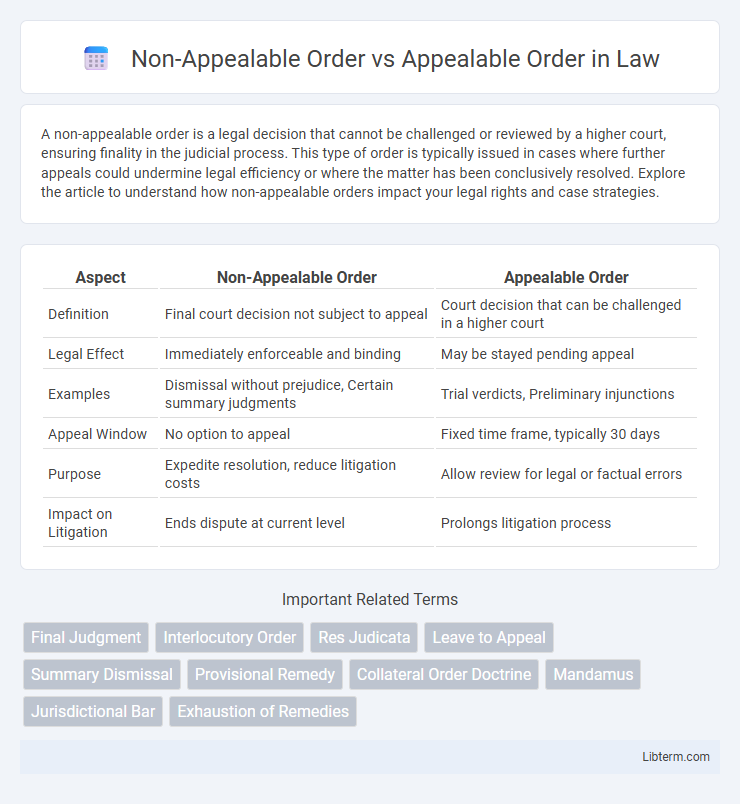A non-appealable order is a legal decision that cannot be challenged or reviewed by a higher court, ensuring finality in the judicial process. This type of order is typically issued in cases where further appeals could undermine legal efficiency or where the matter has been conclusively resolved. Explore the article to understand how non-appealable orders impact your legal rights and case strategies.
Table of Comparison
| Aspect | Non-Appealable Order | Appealable Order |
|---|---|---|
| Definition | Final court decision not subject to appeal | Court decision that can be challenged in a higher court |
| Legal Effect | Immediately enforceable and binding | May be stayed pending appeal |
| Examples | Dismissal without prejudice, Certain summary judgments | Trial verdicts, Preliminary injunctions |
| Appeal Window | No option to appeal | Fixed time frame, typically 30 days |
| Purpose | Expedite resolution, reduce litigation costs | Allow review for legal or factual errors |
| Impact on Litigation | Ends dispute at current level | Prolongs litigation process |
Understanding Appealability in Legal Orders
Non-appealable orders refer to judicial decisions that cannot be challenged or reviewed by a higher court, often because they are preliminary, procedural, or explicitly excluded by statute from appellate review. Appealable orders, on the other hand, are final judgments or specific rulings designated by law that parties can contest through an appeal to a superior court. Understanding appealability hinges on statutory provisions, case law interpretations, and the timing of the order, which collectively determine whether an order qualifies for appellate review under jurisdictional rules.
Definition of Appealable Orders
Appealable orders are judicial decisions issued by a court that can be reviewed and challenged in a higher court, allowing for potential reversal or modification. These orders typically involve substantial rights or legal principles that affect the outcome of a case, providing parties the opportunity to seek appellate intervention. Non-appealable orders, in contrast, are final rulings or determinations that cannot be contested through appeal, often designed to preserve judicial efficiency by limiting review to significant matters.
Definition of Non-Appealable Orders
Non-appealable orders are judicial rulings that cannot be challenged or reviewed by a higher court, typically because they do not conclusively determine the rights of the parties or lack a final disposition. These orders often include interlocutory decisions, procedural rulings, or administrative directives that courts deem premature for appeal. Understanding the clear distinction between non-appealable and appealable orders is crucial for effective legal strategy and timely filing of appeals.
Key Differences Between Appealable and Non-Appealable Orders
An appealable order permits a higher court to review and potentially overturn or modify the decision made by a lower court, ensuring judicial oversight and error correction. In contrast, a non-appealable order finalizes the ruling with no provision for review, typically involving interlocutory or procedural decisions that do not affect the case's substantive rights. The key difference lies in the ability to challenge the order, where appealable orders afford legal recourse and non-appealable orders impose immediate and binding effects.
Legal Criteria for Appealable Orders
Legal criteria for appealable orders require that the order affects substantial rights and conclusively determines the disputed question, preventing irreparable harm if not reviewed immediately. Appealable orders typically resolve material issues or terminate litigation phases, whereas non-appealable orders are interlocutory or preliminary, lacking finality and immediate impact on parties' rights. Courts evaluate jurisdiction, finality, and statutory mandates to distinguish between appealable and non-appealable rulings.
Common Examples of Appealable Orders
Appealable orders commonly include decisions such as civil judgments, interlocutory orders, and administrative rulings that affect substantial rights and can be reviewed by a higher court. These orders allow parties to seek appellate review to ensure proper application of the law and fairness in proceedings. Non-appealable orders, by contrast, typically involve procedural or interim rulings that do not finally determine the case or affect substantive rights.
Common Examples of Non-Appealable Orders
Non-appealable orders typically include decisions such as interlocutory orders, procedural rulings, and certain summary judgments that do not finally dispose of a case. Common examples of non-appealable orders are discovery orders, orders denying a motion to dismiss, and orders on preliminary injunctions, which are generally subject to review only after final judgment. Courts prioritize final orders over non-appealable ones to promote judicial efficiency and avoid piecemeal litigation.
Consequences of Non-Appealable Orders
Non-appealable orders result in final judgments that cannot be challenged or reviewed by higher courts, leading to immediate enforcement of decisions and limiting parties' options for legal recourse. These orders create certainty and finality in litigation by preventing prolonged disputes and reducing court backlog. The inability to appeal non-appealable orders may increase risks for parties, requiring careful consideration before proceedings and settlements.
How to Challenge Non-Appealable Orders
Challenging non-appealable orders requires alternative legal strategies such as filing for a motion of reconsideration, seeking a writ of certiorari, or requesting a review by a higher court to address potential errors. Non-appealable orders lack direct appellate recourse, making procedural remedies like invoking the court's power to correct grave abuse of discretion crucial. Timely and substantive motions targeting these orders must emphasize jurisdictional or legal infirmities to increase the likelihood of successful contestation.
Practical Tips for Lawyers Handling Appealability Issues
When handling appealability issues, lawyers should first verify if a court order is explicitly designated as non-appealable under jurisdictional statutes or procedural rules to avoid wasted motions or appeals. Carefully analyzing applicable rules such as the Federal Rules of Civil Procedure or state-specific codes can clarify whether interlocutory or final orders permit immediate appeal. Documenting and preserving objections at trial while seeking certifications for interlocutory appeals enhances strategic positioning in challenging potentially non-appealable orders.
Non-Appealable Order Infographic

 libterm.com
libterm.com